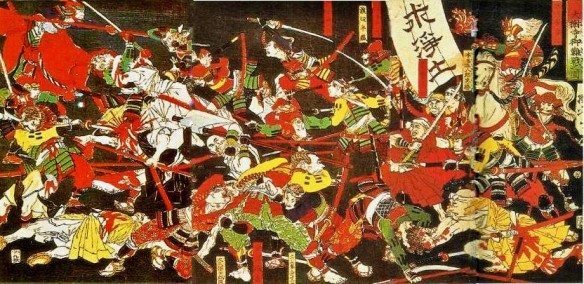The Battle of Azukizaka was the climatic clash between Ieyasu and the Ikki
‘‘Ikkō-ikki’’ or ‘‘single-minded bands.’’ Adherents of Jodo Shinshu, or the True Pure Land sect of Buddhism. Most were warrior monks or peasant farmers.
The Ikkō-ikki bands of the 16th century, due largely to their origins as countryside mobs, used quite varied armor and armament. Many wore the more traditional monk robes, with varying degrees and types of armor. Many wore various sorts of helmets, while many others opted for the straw hat and cloak of a peasant. Naginata remained very common, along with a variety of swords and daggers, and a limited number of arquebuses. Finally, while not truly armor nor armament, a very common item wielded by the mobs of Ikkō-ikki monk warriors was a banner with a Buddhist slogan written upon it. Some of the more common slogans included the nembutsu chant “Homage to Amida Buddha!” (Namu Amida Buts) and “Renounce this defiled world and attain the Pure Land”.
This radical sect was headquartered in the fortress of Honganji in Osaka where it produced its own guns and cannon. Locally, the sect was organized into confederacies that spanned central and eastern Japan. During the Sengoku jidai the confederacies clashed with local daimyo, overturning some. Its adherents seldom gave or asked for quarter so that fights often were unusually bloody and fought to the last man. It became active in opposition to the centralizing conquests of Oda Nobunaga after 1570. In 1574 Nobunaga massacred—without regard to age or gender—all adherents of the sect who lived in the Nagashima delta region, perhaps as many as 20,000 souls. Some he starved to death after refusing mercy; others he burned alive. Sporadic fighting with the sect continued for a decade, until the fall of Honganji in 1580.
Ikko Ikki were a mass militant religious movement based on the peasantry, but with a hard core of conventional warriors and Sohei. They were sometimes fought off by improvised town militia reinforced by local samurai, but such self-defence organisations were considered by the authorities to be almost equally subversive!
Jodo-shinshu Buddhists were organized into leagues known as Ikko ikki. The term Ikko ikki refers to leagues established by members of Jodo-shinshu, also referred to by the name ikko, meaning “singleminded” faith in Amida Buddha. These “League of the Single-Minded” uprisings began in the late 15th century and usually involved large numbers of militant protesters derived from the peasant class seeking self-governance. In the largest and one of the most significant Ikko ikki actions, protestors battled with the lord of Kaga province. The victorious protesters forced the lord to commit suicide. These events inaugurated a nearly 100-year rule by Jodoshinshu adherents in the Kaga region. Ikko ikki protests continued in various parts of Japan until 1580 when Oda Nobunaga destroyed the military capabilities of the League of the Single-Minded.
Hokke ikki was the name for protest leagues among followers of Nichiren Buddhism, a school that was also called the Hokke (Lotus) school because of the importance of the Lotus Sutra to its doctrines and practices. Unlike the Ikko ikki, which appealed especially to peasants, the Hokke ikki was championed particularly by members of the Kyoto merchant and artisan classes who saw these leagues as a way to protect their interests and communities. The Nichiren school had been particularly successful in attracting followers among the nonaristocratic classes in Kyoto. Conflicts arose with the Tendai school on Mt. Hiei, which had in former times been dominant in the capital. Armed conflicts erupted between these two schools in the Muromachi period and it was the Hokke ikki who rose up to defend Nichiren-school interests, both religious and commercial. In the first half of the 16th century, the Hokke protests were finally suppressed by superior forces from Mt. Hiei.
#
‘‘Ikko-ikki’’ or ‘‘single-minded bands.’’ Adherents of Jodo Shinshu, or the True Pure Land sect of Buddhism. Most were warrior monks or peasant farmers. This radical sect was headquartered in the fortress of Honganji in Osaka where it produced its own guns and cannon. Locally, the sect was organized into confederacies that spanned central and eastern Japan. During the Sengoku jidai the confederacies clashed with local daimyo, overturning some. Its adherents seldom gave or asked for quarter so that fights often were unusually bloody and fought to the last man. It became active in opposition to the centralizing conquests of Oda Nobunaga after 1570. In 1574 Nobunaga massacred—without regard to age or gender—all adherents of the sect who lived in the Nagashima delta region, perhaps as many as 20,000 souls. Some he starved to death after refusing mercy; others he burned alive. Sporadic fighting with the sect continued for a decade, until the fall of Honganji in 1580.
Nobunaga’s war against the monks
The militant Buddhists proved far more intractable to Oda Nobunaga’s plans than any rival daimyo. From the early Sengoku Period these armies, largely recruited from peasants, had become something of a third force in Japanese politics. On one occasion they had even ejected a daimyo from his own province and set up a monk-controlled territory. The most important grouping from Oda Nobunaga’s point of view were the Ikko-ikki, fanatics who belonged to the Jodo Shinshu sect of Buddhism. They brought about Japan’s longest siege when Nobunaga was forced to spend 10 years, off and on, reducing their formidable fortress cathedral called Ishiyama Honganji. This was a long and bitter campaign directed against a massive castle complex of the latest style situated within a maze of reed beds and creeks. Supplies were run to them by sea, courtesy of the Mori family, and the Ikko-ikki also had large numbers of arquebuses. Their satellite fortress of Nagashima also held out for years, and was finally reduced when Nobunaga piled up dry brushwood against the outer walls and burned them all to death.
